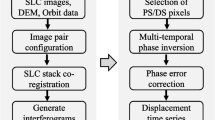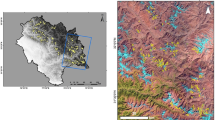Abstract
Land subsidence in Changzhou City in the central Yangtze River Delta of China poses a serious threat to the safety of the environment and infrastructures. Excessive groundwater withdrawal, rapid urbanisation and industrial activities contribute to land subsidence in this area. In this study, we used the multi-temporal InSAR (MT-InSAR) technique to describe the spatiotemporal characteristics of land subsidence in Changzhou. Twenty-five ENVISAT ASAR and 29 TerraSAR-X images acquired from 2004 to 2013 were used to determine the rate and temporal evolution of land subsidence. We used the ERA-Interim model instead of spatiotemporal filtering in traditional MT-InSAR to mitigate the atmospheric phase screen. The InSAR-derived results were evaluated by comparing data from three time series methods and different bands (C and X bands), and accuracy was validated through levelling surveys and GPS measurements. For three regions, a distinct subsidence pattern was observed in major industrial areas with a maximum subsidence rate of up to − 39.9 mm/year. We also characterised the spatiotemporal variations of land subsidence in major industrial areas in Changzhou. The deformation of large-scale man-made linear features, namely high-speed railways, highway networks and a bridge, was analysed. The spatiotemporal characteristics and possible reasons for the observed subsidence were discussed to provide a reference for future urban development planning in Changzhou.











Similar content being viewed by others
References
Amelung F, Galloway DL, Bell JW, Zebker HA, Laczniak RJ (1999) Sensing the ups and downs of Las Vegas: InSAR reveals structural control of land subsidence and aquifer-system deformation. Geology 27(6):483–486
Becker RH, Sultan M (2009) Land subsidence in the Nile Delta: inferences from radar interferometry. Holocene 19(6):949–954
Bekaert DPS, Walters RJ, Wright TJ, Hooper AJ, Parker DJ (2015) Statistical comparison of InSAR tropospheric correction techniques. Remote Sens Environ 170:40–47
Bianchini S, Moretti S (2015) Analysis of recent ground subsidence in the Sibari plain (Italy) by means of satellite SAR interferometry-based methods. Int J Remote Sens 36:4550–4569
Chen X, Zong Y (1998) Coastal erosion along the Changjiang deltaic shoreline, China: history and prospective. Estuar Coast Shelf Sci 46(5):733–742
Cianflone G, Tolomei C, Brunori CA, Dominici R (2015) InSAR time series analysis of natural and anthropogenic coastal plain subsidence: the case of Sibari (Southern Italy). Remote Sens 7:16004–16023
Dee DP, Uppala SM, Simmons AJ, Berrisford P, Poli P, Kobayashi S, Andrae U et al (2011) The ERA-Interim reanalysis: configuration and performance of the data assimilation system. Q J R Meteorol Soc 137:553–597
Deng B, Fan DD (2002) Sea level rise and its impact on sustainable development of Shanghai city. J Tongji Univ 30(11):1321–1325
Doin MP, Lasserre C, Peltzer G, Cavalié O, Doubre C (2009) Corrections of stratified tropospheric delays in SAR interferometry: validation with global atmospheric models. J Appl Geophys 69:35–50
El-Asmar HM, Hereher ME (2011) Change detection of the coastal zone east of the Nile Delta using remote sensing. Environ Earth Sci 62(4):769–777
Farr TG, Rosen PA, Caro E, Crippen R, Duren R, Hensley S et al (2007) The shuttle radar topography mission. Rev Geophys 45:1–33
Fattahi H, Amelung F (2015) InSAR bias and uncertainty due to the systematic and stochastic tropospheric delay. J Geophys Res Solid Earth 120:8758–8773
Gong W, Meyer FJ, Lee CW, Lu Z, Freymueller J (2015) Measurement and interpretation of subtle deformation signals at Unimak Island from 2003 to 2010 using weather model-assisted time series InSAR. J Geophys Res Solid Earth 120(2):1175–1194
Hooper A (2008) A multi-temporal InSAR method incorporating both persistent scatterer and small baseline approaches. Geophys Res Lett 35(16):96–106
Hooper A, Zebker H (2007) Phase unwrap** in three dimensions with application to InSAR time series. J Opt Soc Am A 24(9):2737–2747
Hooper A, Zebker H, Segall P, Kampes B (2004) A new method for measuring deformation on volcanoes and other natural terrains using In SAR persistent scatterers. Geophys Res Lett 31(23):1–5
Hooper A, Segall P, Zebker H (2007) Persistent scatterer interferometric synthetic aperture radar for crustal deformation analysis, with application to Volcan Alcedo, Galapagos. J Geophys Res 112:1–21
Jung J, Kim DJ, Park SE (2014) Correction of atmospheric phase screen in time series InSAR using WRF model for monitoring volcanic activities. IEEE Trans Geosci Remote Sens 52(5):2678–2689
Lin H, Ke C (2016) Monitoring surface deformation in Changzhou city using COSMO-SkyMed data. Remote Sens Technol Appl 31(3):599–606
Liu B, Yan WB, Fan XT, Lu FF (2016) Study on the application for ground subsidence monitoring in Wu** district based on SBAS technology. Modern Surv Mapp 39(4):9–12
Miao XT, Zhu XX, Lu ML, Chen FC, Huangfu AF (2007) Groundwater exploration from the confined aquiferous II and land subsidence control of Suxichang area. Chin J Geol Hazard Control 18(2):132–139
Saastamoinen J (1972) Atmospheric correction for the troposphere and stratosphere in radio ranging of satellites. The Use of Artificial Satellites for Geodesy. Geophys Monogr Ser 15:247–251
Siles GL, Alcérreca-Huerta JC, López-Quiroz P et al (2015) On the potential of time series InSAR for subsidence and ground rupture evaluation: application to Texcoco and Cuautitlan–Pachuca subbasins, northern Valley of Mexico. Nat Hazards 79:1091–1110
Syvitski JPM, Kettner AJ, Overeem I, Hutton EWH, Hannon MT, Brakenridge GR, Day J et al (2009) Sinking deltas due to human activities. Nat Geosci 2(10):681–686
Tornqvist TE, Wallace DJ, Storms JEA, Wallinga J, Van Dam RL, Blaauw M, Derksen MS, Klerks CJW, Meijneken C, Snijders MA (2008) Mississippi Delta subsidence primarily caused by compaction of Holocene strata. Nat Geosci 1(3):173–176
Wang M, Li T, Jiang L (2016) Monitoring reclaimed lands subsidence in Hong Kong with InSAR technique by persistent and distributed scatterers. Nat Hazards 82(1):531–543
Wu T, Kang JC, Li WJ, Meng F, An Y, Wang TT (2007) Advance of sea level change research in China. Mar Geol Quat Geol 27(4):123–130
Wu J, Shi X, Xue Y, Zhang Y, Wei Z, Yu J (2008) The development and control of the land subsidence in the Yangtze Delta. China Environ Geol 55(8):1725–1735
Wu JC, Shi XQ, Ye SJ, Xue YQ, Zhang Y, Yu J (2009) Numerical simulation of land subsidence induced by groundwater overexploitation in Su-**-Chang area. China Environ Geol 57(6):1409–1421
Xue YQ, Zhang Y, Ye SJ, Wu JC, Li QF (2005) Land subsidence in China. Environ Geol 48(6):713–720
Yuan R, Chen S, Tao Y, Xu H (2001) Problems in exploiting groundwater and sustainable development countermeasures in Suxichang area. Acta Sci Nat Univ Pekin 37(4):537–542
Zhang L, Chan RCK, Wu C (2003) Land subsidence problem and its control in Taihu Basin of South Jiangsu Province due to overexploitation of underground water. J Lake Sci 15(3):257–262
Zhu W, Liu F (2008) Surface subsidence observations and results analysis in Changzhou. Eng Surv Mapp 16(6):54–57
Zhu B, Li J, Chu Z, Tang W, Wang B, Li D (2016) A robust and multi-weighted approach to estimating topographically correlated tropospheric delays in radar interferograms. Sensors 16(7):1078
Zhu B, Li J, Tang W (2017) Correcting InSAR topographically correlated tropospheric delays using a power law model based on ERA-Interim reanalysis. Remote Sens 9(8):765
Acknowledgements
This research was funded by Bei**g Key Laboratory of Urban Spatial Information Engineering, No. 2018211, the National Natural Science Foundation of China (41806117), Key Laboratory of Geospace Environment and Geodesy, Ministry of Education, Wuhan University (No. 18-01-04), the Natural Science Foundation of Jiangsu Province (No. BK20180720) and the Research Project of Nan**g Research Institute of Surveying, Map** and Geotechnical Investigation, Co. Ltd (2018RD01 and 2018RD03).
Author information
Authors and Affiliations
Corresponding author
Additional information
Publisher's Note
Springer Nature remains neutral with regard to jurisdictional claims in published maps and institutional affiliations.
Rights and permissions
About this article
Cite this article
Zhu, B., Chu, Z., Shen, F. et al. Land subsidence (2004–2013) in Changzhou in Central Yangtze River delta revealed by MT-InSAR. Nat Hazards 97, 379–394 (2019). https://doi.org/10.1007/s11069-019-03650-z
Received:
Accepted:
Published:
Issue Date:
DOI: https://doi.org/10.1007/s11069-019-03650-z




